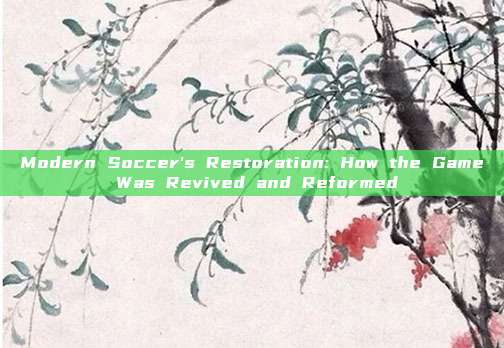**Modern Soccer's Restoration: How the Game Was Revived and Reformed**

**Introduction**
In a world where soccer has become more than just a sport, but a global phenomenon that unites millions of fans from every corner of the planet, it is easy to forget the challenges it faced in the past. From its humble origins to becoming the most popular sport on Earth, soccer has undergone numerous transformations, both on and off the field. This article explores the journey of modern soccer’s revival and reform, examining the key moments that shaped the game as we know it today.
**The Early Days of Soccer**

Soccer, or football as it is known in many countries, has ancient roots dating back thousands of years. However, it wasn't until the 19th century that the sport began to take shape in its modern form. The rules were standardized, and the first official matches were played. Despite this progress, soccer faced significant obstacles, including social class divisions and limited resources for training and infrastructure.
**Reviving Interest in Soccer**
By the late 20th century, soccer had already established itself as a beloved pastime, but it was not immune to periods of decline. Factors such as economic downturns, lack of investment, and competition from other sports threatened to diminish its popularity. To combat these challenges, several key initiatives were launched:
### **Investment in Youth Development**
Recognizing the importance of nurturing young talent, many clubs and national associations began investing heavily in youth academies. These programs provided structured training, education, and mentorship, helping to develop future stars and instill a love for the game from an early age.
### **Expanding Global Reach**
To broaden its appeal, soccer organizations sought to reach new audiences through international tournaments and tours. This strategy not only introduced the sport to new markets but also fostered a sense of global community among fans.
### **Technological Advancements**
Advancements in technology have played a crucial role in the evolution of soccer. Innovations like goal-line technology, video assistant referees (VAR), and performance tracking systems have enhanced the fairness and accuracy of the game while also providing fans with engaging insights into player performance.
**Reforming the Game**
While reviving interest in soccer was essential, addressing the sport's structural issues was equally important. Here are some of the key reforms that have reshaped modern soccer:
### **Financial Fair Play Regulations**
To promote financial stability and sustainability within clubs, regulatory bodies implemented Financial Fair Play (FFP) rules. These regulations aim to prevent clubs from overspending and accruing unsustainable debts, ensuring a level playing field and long-term viability for all teams.
### **Combatting Discrimination**
Soccer has not been immune to issues of discrimination, including racism, sexism, and homophobia. Efforts to combat these problems have included educational campaigns, stricter penalties for offenders, and the establishment of support networks for players and fans.

### **Enhancing Fan Engagement**
Understanding the importance of fan engagement, clubs and leagues have adopted various strategies to connect with supporters. Social media platforms, interactive apps, and matchday experiences have all been used to enhance the fan experience and build loyalty.
**The Role of Key Figures**
Throughout the history of soccer, certain individuals have left an indelible mark on the sport. Whether through their leadership, innovation, or sheer talent on the pitch, these figures have been instrumental in shaping the game's direction. Some notable examples include visionary coaches who revolutionized tactics, pioneering administrators who drove reform, and iconic players whose performances captivated the world.
**The Future of Soccer**
As soccer continues to evolve, the focus remains on maintaining its core values while embracing change. Initiatives aimed at improving player welfare, enhancing the fan experience, and promoting inclusivity will be critical in shaping the sport's future. Additionally, ongoing efforts to address climate change and sustainability will ensure that soccer remains a force for good in communities around the globe.
**Conclusion**
The journey of modern soccer's restoration and reform is a testament to the resilience and adaptability of the sport. Through strategic investments, innovative reforms, and a commitment to inclusivity, soccer has not only survived but thrived, becoming a source of inspiration and unity for billions worldwide. As we look to the future, the challenge lies in preserving what makes soccer special while continuing to innovate and inspire new generations of fans and players alike.





